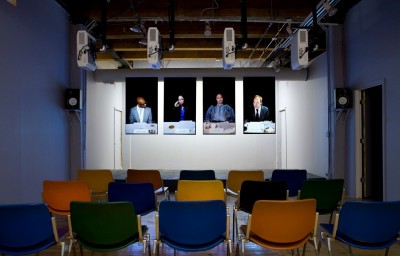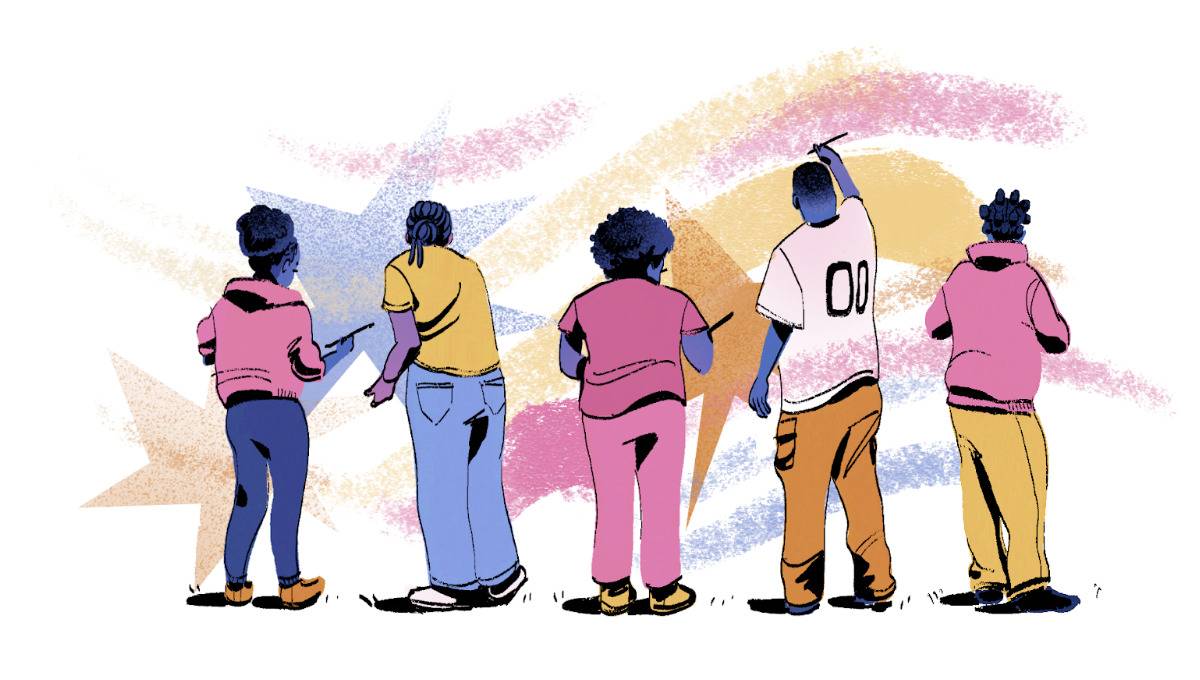In the back room at threewalls, someone had set up a folding table on a raised platform, four empty chairs behind four nameplates, four empty water glasses, a television screen, a microphone, and a few rows of seating facing forward. People wandered in, sat down, and eleven or so minutes after the hour, Mary Patten’s “Schizo Panel” performance began.
A short screened introduction by philosopher Sylvère Lotringer set the scene for a reenactment of a discussion panel, originally held in 1975 in New York, titled “Schizo Culture.” The event has since become something of a landmark; it was hosted by Lotringer, and it featured previously unrecognized icons in French post-structuralist philosophy, such as Gilles Deleuze, Felix Guattari, and Jean-Francois Lyotard, as well as Michel Foucault, John Cage and William Burroughs. The event centered around critiques of the prison system, institutionalization, madness and schizophrenia, capitalism, and a discussion of feminism and psychoanalysis, among other revolutionary topics of the era.
Mary Patten’s “Panel” distances itself somewhat from this sourcing by adding a refreshed version of Judy Clark (a radical political activist) and the mysterious Howie Harp. Impersonations of psychologist R. D. Laing and Michel Foucault completed the four-person panel. The performance proceeded predictably from there: the performers read smoothly through selected excerpts from the original discussion, nods and eloquent verbal sparring ensued. The performers acted their parts, save a few desultory addendums: this Michel Foucault was black, and R. D. Laing wore no shoes. This could be left to rest as a propitiously timed remembrance of a seminal event, the discourse still relevant and the bad politics still extant almost forty years later. We could allow this gesture to capture us in concept, and reside inside the ideas as they are presented. But as a participating member of the audience, I am not content to do so.
“Schizo Panel” posed some interesting problems concerning the performer-audience relationship, the functions and implications of the (or any) institution, and the criteria one uses to judge the “success” of an artwork. I might argue, perhaps prematurely, that any work that brings such myriad concerns to the fore is doing something right — but, still, “Schizo Panel” left me (or rather, I left it) ambivalent. As a viewer, it alienated me. My complicit relationship was threatened from the start, beginning with the intimidating cultural and intellectual framework on which it rested and running through the course of the performance, where my attention was so poorly directed that I focused equal attention on the prosaic formalities and the actual performance. I was incarcerated in an ambivalent relationship with the performers, who spoke at everyone and to no one.
As a performance, as a work of art, the critique of the institution is a clever, but deeply buried, pun: employing the forms that other artists might eschew based on their institutional trappings (a formal discourse, “true” acting, a tradition-laden variety of props), Patten has turned the critique back on itself, lightly chiding what was (once) a radical forum and simultaneously catching the audience in a similar exchange, where we pause the criticality we bring to other artworks in the face of such un-art-like formality. Some of the audience actually chanted for a “question and answer” session to take place after the performance concluded; as though it wasn’t a performance at all; as though the performers could perform right into the present, out from behind the table, out of the galley and into the contemporary world. But they did not, and could not. Rather than foster a refreshed dialogue around these still-relevant concepts, the work lost its aim and its potential to re-imbue its audience with a radical-political fervor. Though I assume the scripts were faithful to the authentic voices, the discourse was almost totally lost in translation. There were moments when I was able to reposition myself, as a silent and absorbent participant, within this compelling, regurgitated tirade, and climb aboard the arguments as one would a sinking ship. But I ultimately drowned in the suction of the setting, the contextual implications of the gallery space, and the multiple misfiring of intention. I could not locate the crux or target of the work as a performance. I was unsure of my role, the role of the actors, and the aim of the work (if not the discourse) that I couldn’t align myself to it’s trajectory; I couldn’t fall faithfully into the reenactment. The discourse withered in reconstitution, and my own ambivalence marked the death of a performance that was ambivalent in return.






















